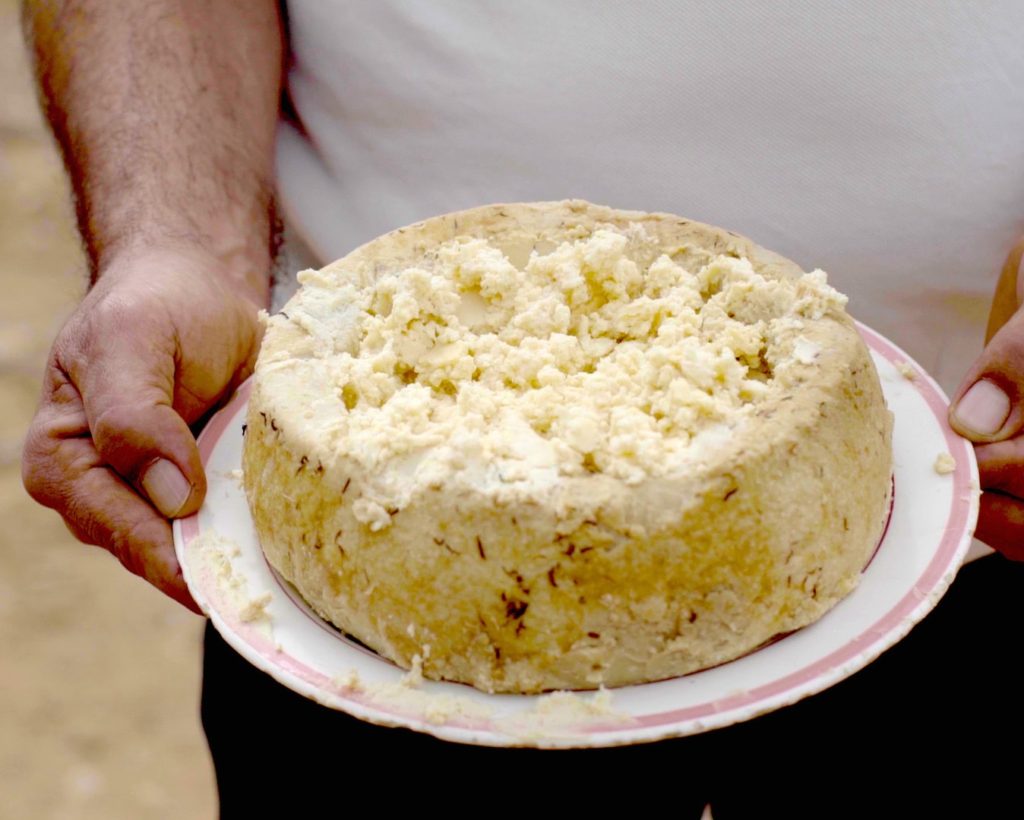Let’s talk about a maggot infested cheese that has been banned in its own country. That got your attention right? Read on to learn about Casu Marzu, a Sardinian delicacy that is not for the faint-hearted.

Where does Casu Marzu come from?
Casu Marzu is a maggot-infested pressed cooked cheese that finds its roots on the Italian island of Sardinia. In fact, casu marzu means “rotten cheese” in the local language. Locally, the cheese is also known as Casu Martzu, Casu Modde and Casu Cundidu.
Sardinia sits in the middle of the Tyrrhenian Sea, and is surrounded by a 1,849-kilometer coastline of white sandy beaches and emerald waters. However, the island’s inland landscape rapidly rises to form hills and impressive mountains, which are home to this unique cheese.
In 2009, the Guinness World Records proclaimed this Sardinian delicacy to be the world’s most dangerous cheese.
How Casu Marzu is made
Quite remarkably, this traditional cheese starts its life as a fairly vanilla Fiore Sardo (also known as Pecorino Sardo). Indeed, local farmers make this hard cheese using the raw milk of their sheep.
However, Casu Marzu deviates from Fiore Sardo at the maturation stage. As the cheese dries out, it starts to crack on the surface. At this stage, cheese skipper flies, Piophila casei, lay their eggs in the cracks that form in the cheese.
As the maggots hatch, they make their way through the inside of the cheese, and digest the proteins. Consequently, the texture breaks down to produce a spoonable creamy cheese.
As the seasons change
Production of this historic cheese typically takes place at the end of June when local sheep’s milk being to change.
It is said that is a warm sirocco wind blows on the day the cheese is made, the flies lay even more eggs inside. The reason for this is because the cheese tends to be a bit softer when the weather is warm. After three months, the cheese is ready for consumption.
Banned for commercial use
Even though this cheese is part of the region’s cultural heritage, it has legally been banned for sale, even on the island.
Since 1962, the Italian government has established laws that prohibit the consumption of food infected by parasites. In fact, anyone who sells this cheese can face fines up to €50,000 (about $60,000). Having said that, most Sardinians laugh when asked about the prohibition of their beloved cheese.
What Casu Marzu tastes like
The biggest challenge to consuming this cheese is the visual aspect. If you can look past the writhing maggots, Casu Marzu has quite a remarkable flavour with intense nots of Mediterranean pastures and a spicy aftertaste.
How to serve Casu Marzu
When serving Casu Marzu, you start by cracking open the top to scoop out a spoonful of the creamy insides.
Actually, most locals do not remove the maggots and eat them raw (and alive) together with the cheese. For those who prefer not to eat the maggots, they can suffocate them by sealing the cheese in a bag. This forces them out of the cheese.
Thank you for reading
Thank you for reading this post about yet another amazing artisanal cheese. Have you tried this cheese before? Drop us a comment below with your thoughts.
If you enjoy learning about new cheeses, you can subscribe to our newsletter below. You will hear from us about once a week as we share new cheese profiles with you.
Finally, keep scrolling to find some more cheeses and recipes that have been recommended for you. Keep it cheesy!
Good to know as this rare type of cheese may cause health issues. However who knows, parasites can become part of our diet in future. 😆
Thank you for your comment. Who knows where we will be getting our protein from in the future!